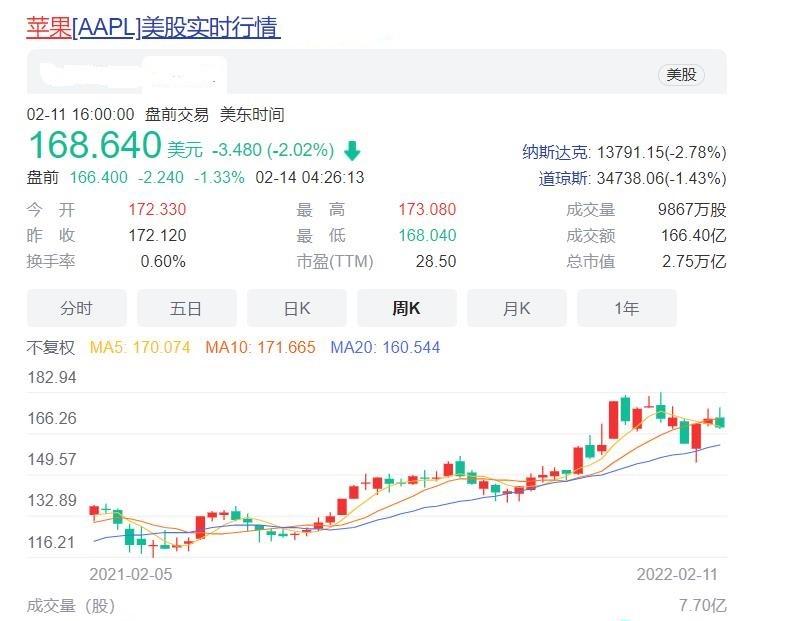On August 3, 2018, Apple's stock exceeded $1 trillion for the first time, becoming the first company in the world to enter the trillion-dollar club.
On August 20, 2020, Apple's stock exceeded $2 trillion, and it was also the first to enter the $2 trillion club. This trillion-dollar increase took 2 years.
In the intraday on January 4, 2022, the market value of Apple's stock once exceeded $3 trillion, and this time it took only 1 year and more than 4 months to increase by $1 trillion.

Behind such a popularity among investors is Apple's financial performance in bucking the trend during the epidemic.
In fiscal 2020, when the global epidemic was extremely serious, most countries were shut down, and stores were difficult to operate normally, Apple's total revenue still reached $274.515 billion, an increase of 5.51% year-on-year; net profit was $57.411 billion, an increase of 3.9% year-on-year. Such achievements are really rare.
In fiscal 2021, apple's performance has exploded due to the trend of human adaptation to the epidemic. The company's operating income was US$365.817 billion and net profit attributable to the parent company was US$94.680 billion, equivalent to EARNINGS PER SHARE OF US$5.67.
Nearly 100 billion US dollars in profits are definitely a properly rich and invincible country, after all, the vast majority of countries in the world can not make so much money in a year.
Of course, as the world's largest company by market capitalization, Apple also feeds many supply chain companies.
According to the information released on the company's official website, since 2018, although the list of supply chain enterprises has been adjusted, the scale of suppliers has been maintained at about 200.
In the list of suppliers released in 2021, Chinese mainland added 12 more, bringing the total to 42, including 46 in Taiwan and 10 in Hong Kong. There are 98 Chinese companies in Apple's supply chain, accounting for 49% of the total number of suppliers, a veritable half of the country.
In contrast, the second-ranked country is the United States, with 35 suppliers, accounting for about 17.5%,; followed by 33 in Japan, accounting for about 16.5%, and South Korea's 14, accounting for 7%. The remaining other countries all add up to only 20, accounting for 10%.
Among the 42 suppliers Chinese mainland, many companies have grown into listed companies relying on this "big tree"; and companies that have been listed have become well-known listed companies.
Among them, there are many names that we are familiar with: Luxshare Precision, Goertek Shares, Pengding Holdings, Desai Battery, Lens Technology and so on. The proportion of Apple's product supply chain business in these companies is as follows:
The proportion of Apple product business of Chinese enterprise suppliers
From the chart, we can see that the operating income brought by Apple has become the main source of income for these companies, with the highest reaching 80% and the lowest 30%.
In addition to the number of supplier enterprises, Chinese companies occupy an absolute share, and the production bases of these suppliers are also the largest in China. As of the third quarter of 2021, there were 809 factories providing Apple with various raw material production and assembly, while in China it accounted for 380, accounting for 47%, while the United States only had 106, accounting for just over 13%.
Moreover, many of the major suppliers have most of their production bases in China.
For example, the assembly supplier Foxconn has 35 production bases around the world, 29 in China, and the remaining 6 in India, Vietnam, the United States and Brazil.
For example, circuit board supplier Wistron Capital has 5 production bases, 3 in China and 2 in India.
For example, another assembly supplier, Pegatron, 12 of the 17 production bases in China, the remaining 5 are all in developed countries, namely the Czech Republic, Singapore, South Korea, Japan and the United States.
For example, Jabil and Micron, although they are both American suppliers, they have more factories in China than in the United States.
Not to mention the suppliers of Chinese mainland, such as Luxshare Precision 8 production bases, 7 in China, one in Vietnam; Goertek has three production bases, 2 in China and 1 in Vietnam.
It is worth mentioning that even Intel, the supplier of processors, has set up a production base in China.
In this way, we are still the world factory, but this "world factory" belongs to version 2.0.
If you have enough patience to inquire and understand Apple's specific procurement distribution of 200 suppliers, you will find that although China occupies half of the entire territory of suppliers, our suppliers are mostly contracted for assembly business, even if it is the supply of production materials, most of them are edge components, and they rarely design core components - this piece is mainly controlled by American, Japanese and Korean companies such as Intel, Qualcomm, Texas Instruments, 3M, Murata Manufacturing and Samsung.
Therefore, our company still has a lot of room for upgrading, and then we should reach the supplier of core components, so that our "world factory" will also be upgraded to version 3.0.
Of course, even if it is version 3.0, in the entire product industry chain, it is still only the role of drinking soup, or attached to the designer of the product, compared with Apple,corp.
Therefore, improving their technical capabilities, creating core competitiveness, and building an international brand is the king.
This article will be shared with you here, welcome to click to follow!
The original works of "Joke Finance" shall not be reproduced without permission!